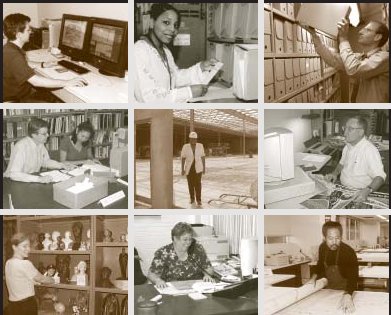Guide to NARA Collection
Social Security Textual Records in NARA II
Part 2: The Federal Records Process and Research at NARA
A Brief Explanation of the NARA Finding Aids for Social Security Records
The Finding Aids maintained by NARA for RG-47 are a mixture of documents developed over many years. As a general rule, they are not uniform nor are they very descriptive, and researchers often need expert help from NARA's archivists in order to decipher them.
The Master Locator Record (MLR)
The top-level Finding Aid for RG-47 is the Master Locator Record (MLR).
The MLR is a computer database which lists the RG-47 records. Generally
speaking, NARA's groupings are determined by the accessions sent to NARA
by SSA. Each accession tends to become a separate entry in the MLR, even
if the records all pertain to the same subject or are records of the same
organization within SSA. In other words, NARA does not endeavor to organize
RG-47 into any category scheme immediately useful to researchers. Rather,
it is the physical housing and inventory of the records which is the controlling
factor for NARA.
Thus the MLR is, as the name implies, simply a database to locate a particular
box of material within NARA. It has no descriptive content beyond the
general title of the records in a particular entry. So, for example, the
160 boxes of material from the Central Files of the Social Security Board
for 1935-1947, involving Regional records, are all included in a single
MLR entry with the title "Regional File, 1935-1947." This single
entry, "Regional File, 1935-1947," the fact that there are 160
boxes, and their physical location, is all the MLR will tell you about
these records. Not only that, but related records from the Social Security
Board for this same period will not necessarily be found anywhere near
this particular entry in the MLR.

NARA employees at work
Within the
MLR, there are several different types of entries, based on a variety
of different inventories done by NARA over the years. There are six separate
inventories in the MLR (called Finding Aids in the MLR database--but they
are really inventories). The RG-47 records are grouped into these six
sub-categories. The MLR sub-categories are:
A1
PI-183
UD
UD-UP
UD-WW
UD-ZZ
These codes have no meaning to a researcher, but they help NARA staff
pinpoint an entry in the MLR. The MLR is the main tool which NARA archivists
use to locate material in RG-47 and traditionally researchers also must
make use the MLR if they wish to retrieve material from RG-47. (This
new SSA-produeced Guide can be used by researchers in lieu of the MLR,
and it is designed to be more immediately meaningful to a researcher--although
researchers should understand NARA's MLR system as this is still the central
inventory for NARA's purposes.)
As mentioned, there is virtually no descriptive information in the MLR
itself. Since the MLR categories refer to other inventories, in theory
these other inventories could contain some descriptive information. In
fact, only the inventory labeled PI-183 contains any useable descriptive
information. PI-183 (the PI referring to Preliminary Inventory) was an
inventory NARA published in 1976. In addition to the Bortz Guide, it was
the only existing descriptive listing of the records in RG-47, and, like
the Bortz Guide, it has long been out-of-date.
To make the MLR more useful, the Archivists at NARA have over the years
collected additional documents which have been added to the MLR to comprise
the complete set of Finding Aids for RG-47.
Other Material in the NARA Finding Aids
The federal records process involves the transmission of records from
agencies to NARA, usually by way of the FRCs. These transmissions, called
accessions, are accompanied by some paperwork. There are standard government
forms which agency Records Officers use to send their boxes of material
to NARA. The first is NARA Standard Form 135, which is used to transmit
boxes of material from the agencies to the Federal Records Centers. The
Standard Form 258 is used to move boxes of material from the FRCs to the
permanent custody of NARA . On these forms the Records Officers may describe
the contents of the boxes. How detailed these descriptions are, and whether
there are any descriptions at all, depends upon the practices of the various
government Records Officers. SSA has traditionally done a fairly good
job of preparing these forms and hence they sometimes contain descriptive
information about the records.
Due to the paucity of descriptive material, NARA has been treating the
135 and 258 forms as finding aids for RG-47. The binder of finding aids
for RG-47 at NARA II thus contains many such transmittal forms, of varying
detail and usefulness. As finding aids, the 135 forms have serious limitations.
Their main virtue is that they are in many cases the only documentation
available. Indeed, the 135 forms are the ONLY content description for
materials in the FRCs. There are no finding aids for material at the FRCs,
since their purpose is not to serve materials to researchers but only
to warehouse records until they are no longer needed in the agency's ongoing
business. The 258 forms are similar in content and usability to the 135
forms.
In addition to the shipping-list forms, the Archivists have included a
few additional odds-and-ends of documentation for RG-47. Indeed, the main
problem with the present RG-47 finding aids, from a researcher's point-of-view,
is that they present a hodge-podge of documents of varying formats, ages,
and degrees of usefulness. The Archivists and support staff at NARA are
very helpful in assisting researchers in sorting through the RG-47 finding
aids (indeed they are indispensable!), but the finding aids themselves
need to be rationalized and updated--which is the reason we have produced
this new Guide to RG-47.